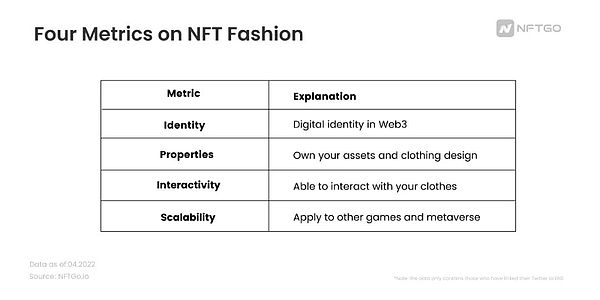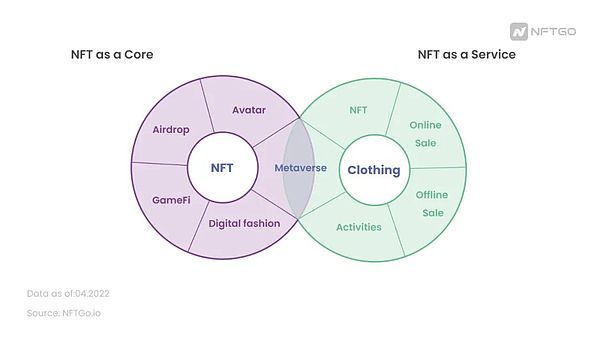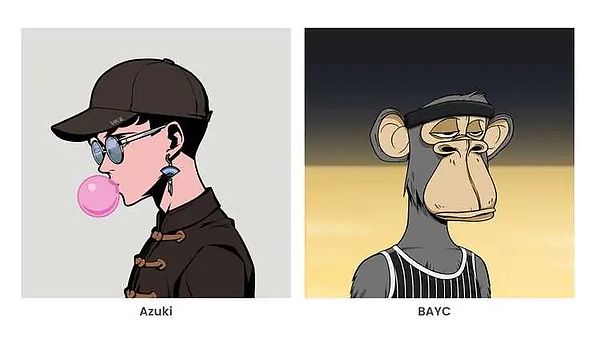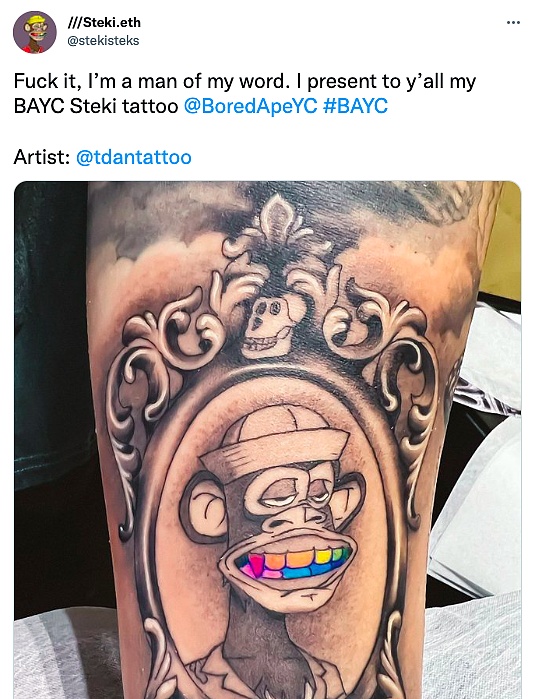NFT Fashion: Fans, Culture, and New Consumption
Author: NFTGo
In recent years, the fashion industry has followed the trend of the times and entered the digital age. With changes in population structure, the main consumer group is gradually transitioning to Generation Z. Among fashion brands venturing into NFTs, there are globally popular established fashion companies as well as emerging projects that only deal with virtual fashion. The fashion industry and NFTs have various ways of integration and strategies, from the basic combination of NFT IP in fashion to the transformation of virtual brands into reality, NFTs are subtly influencing the current economic model.
Currently, the empowerment of the fashion industry by NFTs can be divided into four main approaches:
- First, digital brands based on NFT issuance, creating virtual products and experiences, such as RTFKT, BAYC, etc.;
- Second, fashion design aimed at the metaverse, focusing on virtual clothing within the metaverse, such as The Fabricant;
- Third, virtual experiences on top of real fashion, seeking new consumer groups through secondary design with PFP IP, such as Li Ning;
- Fourth, the consumption expansion of NFTs under luxury brands, gradually leveraging their influence to enter the NFT field, such as Gucci.
The combination of NFTs and the fashion industry has four metrics worth noting: Identity, Properties, Interactivity, and Scalability. Based on these metrics, we distinguish how Web3 and Web2 fashion companies view the value and approach of NFTs.
Data Source: NFTGo.io
In the Web3 fashion industry, whether it is sales, exhibitions, collaborations, or applications, NFTs play a core role in the industry. Projects aggregate a multitude of fans through the power of digital IP, gathering participants in a DAO format, and empowering them in GameFi gameplay and metaverse applications through airdropping digital fashion. Rarity and secondary market trading increase the liquidity of the clothing itself. The later physical and offline businesses are merely embellishments, rather than necessities.
In contrast, most Web2 companies treat NFTs as a tool. Essentially, from production and sales to feedback across the entire industry chain, it is based on physical sales. NFTs are used as a marketing hotspot, driving new consumer traffic and brand upgrades. At this level, brand displays in the metaverse represent a new marketing channel. Through the NFT hotspot, brands maintain visibility and create new revenue streams.
Data Source: NFTGo.io
Cultural Confrontation between Web3 PFP and Native Fashion Brands
Compared to traditional fashion and luxury brands, Web3 has cultural dissemination differences.
Traditional fashion brands rely on annual fashion events and media news to transmit their values "top-down" to the public, while Web3's new form of communication leans towards "decentralization" and "community culture." Thus, we see that the birth path of the popular culture of BAYC and Azuki is "bottom-up," filled with rebellion and symbols, aligning more closely with the native culture of Crypto.
The popular fashion derived from the essential attributes of NFTs aligns more with people's consensus on the Web3 trend, while "traditional fashion + NFT" seems more like an import from an old era.
As the saying goes, "no breaking, no standing," new fashion is never grafted from classical aesthetics; in its early stages, it often embodies "non-mainstream" and "rebelliousness," much like Beethoven in classical music and Van Gogh in the 19th-century painting school.
Similarly, the streetwear culture represented by BAYC and Azuki is spreading from Web3 to Web2, for example: organizing offline events and streetwear collaborations. Thanks to the enhancement of native community culture, their fans exhibit greater "loyalty" and cultural roots than previous customers, which traditional fashion brands lack, and this is also why traditional fashion brands always feel a distance from these native cultures.
Independent Brands Based on NFT Issuance
Currently, many brands specializing in digital fashion are warming up through the issuance of NFTs and collaborating with other industries to bring new business opportunities.
RTFKT
Founded in 2019, RTFKT's name is a homophone for "artifact." It was acquired by Nike last December. In February, anyone holding Clone-X could receive a mysterious box called MNLTH. Last Friday, holders of RTFKT's MNLTH could burn their NFTs to exchange for Nike Cryptokicks digital sneakers. Additionally, the sneakers can be customized with "skins," with the highest transaction price reaching 73.3 ETH, while the floor price remains stable around 2.54 ETH, having slightly decreased in recent days.
Data Source: NFTGo.io
Fashion Design for the Metaverse
The rise of the metaverse and NFTs has driven a brand new digital economic ecosystem, where virtual experiences and interactive economies have become mainstream. A complete virtual identity can be manifested in various ways, such as avatars, virtual real estate, and clothing.
With the improvement of the metaverse's infrastructure and the development of virtual avatars in online meetings, individuals can showcase their attire in the metaverse and virtual meetings, expressing themselves through digital characters and clothing. Metaverse platforms, including Decentraland, also have their own series of Wearables or collaborate with other brands for fashion releases and sales.
Genies
After financing in April, Genies was valued at $1 billion. On the platform, users can create digital avatars and a digital wearable fashion collection, owning IP that can be monetized in suitable ways.
Republiqe
Republiqe creates unique digital 3D clothing and products while collaborating with brands to create customized digital avatars and models. Through partnerships with games and virtual platforms, Republiqe can proportionally dress virtual characters and real people.
The Fabricant
Many people still remember Iridescence from 2019, the first purely digital dress sold in the blockchain world for $9,500. The Fabricant recently raised $14 million, focusing on creating virtual avatars. The phrase "ALWAYS DIGITAL, NEVER PHYSICAL" reflects The Fabricant's positioning.
Additionally, some well-known clothing studios have launched their own digital ready-to-wear brands. For example, AuroBoros, originally a clothing studio based in London, debuted a purely digital ready-to-wear collection at London Fashion Week, with its "bionic" digital series sold as NFT fashion on the Decentraland platform.
Virtual Experiences Based on Real Clothing
The combination of reality and virtuality mainly has two approaches.
One is to purchase well-known PFP NFTs and sell them through secondary design. For example, Li Ning released fashion designs based on BAYC#4102 and an upcoming pop-up store sale.
The other is that customers can scan the accompanying barcode after purchasing physical clothing to obtain a virtual counterpart. For example, Overpriced has its hoodie priced at $26,000 on the NFT platform BlockParty.
Consumption Expansion of NFTs under Luxury Brands
Gucci
Gucci is one of the early luxury brands to enter the NFT field. Its first NFT collection was not designed based on its fashion products but was inspired by a film from their collaboration with Alessandro Michele's Aria series, which sold for $2.5 million at a Christie’s auction.
Louis Vuitton
LV launched a mobile game called "Louis the Game" to commemorate the 200th anniversary of the company's founder, telling the brand's history and culture. The game's Easter egg prize is a set of Louis 200 NFTs, totaling 30, created in collaboration with renowned NFT artist Beeple.
Dolce & Gabbana
Dolce & Gabbana launched nine collections at Venice Fashion Week, with a total auction price of $5.56 million. Besides NFTs, buyers can also receive physical products and VIP access to D&G events. Additionally, Dolce & Gabbana plans to launch a $10 million "Cultural Fund" aimed at promoting the development of NFTs in the fashion industry.
Digital fashion will also have many display opportunities. With the spread of the COVID-19 pandemic, many fashion weeks are currently adopting online formats, and NFTs have become the new favorite at fashion weeks. "French Fashion" and the "Federation de la Haute Couture et de la Mode" collaborated with the Arianee platform to create NFTs for exhibitors to use at the 2022 Paris Men's Fashion Week, allowing users to browse exclusive fashion.
Currently, luxury brands in the NFT field basically maintain their positioning in the real world, whether in terms of artistry, pricing, or target demographics: high positioning, high consumer groups, and high artistry.
Sustainability and the Future of Fashion
The creative director of The Fabricant once mentioned, "The digital world is coming; we are no longer bound by physical space and are slowly entering a completely new system that has an inner model closer to human instincts, born from slow evolution rather than controlled by central powers. When a person is liberated from the constraints of the physical body, what will they become? When endless bits and bytes express identity, what does our identity mean? We yearn to stick our heads out and seek new worlds, and the window to the new world is gradually being established; humanity's infinite potential is the driving force behind all of this."
Fashion actually represents an attitude and conveys a thought. People's consumption behavior and psychology in reality will also horizontally migrate to the Web3 field, and the pursuit of rarity and personalization has never stopped and will not stop. Factors such as attitude expression and identity recognition make virtual fashion increasingly important. The combination with NFTs is one of the entry points for fashion and the Web3 world.
Everything in Web3 is built on the foundation of consensus. Whether digital assets or NFTs, they possess a strong consensus foundation, making all of this possible. Currently, the entire consumer industry is in a transitional and chaotic stage of Web2.5, where the past economic growth drivers have gradually faded, and the market needs new consumer content and hotspots.
Good brands and stories also originate from consensus. Whether it is the entry of traditional fashion industry enterprises or the emergence of digitally native virtual fashion brands, it is essential to clearly understand their positioning in the industry. From virtual to reality, from reality to virtual, or purely digital virtual, it is necessary to consider the value of "virtual" itself.

















